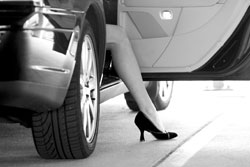
For many women, a great pair of heels can offer confidence on a date, a self-esteem and height boost or simply a satisfying, authoritative click on the office floor. Besides their fashionable and emotional benefits, however, pumps do not boast many positive attributes. In fact, a December 2007 Bodywise survey found that 80 percent of female participants reported foot problems, mostly due to their shoes. Although it seems unlikely that function could trump fashionable form, the unhealthy structure of heels is increasingly found wanting.
According to the Mayo Clinic, wearing heels two inches or higher causes your foot to slide forward and redistributes your weight, “creating unnatural pressure points and throwing your body’s natural alignment out of whack.” Pumps that are too narrow or short—usually the pointed-toe variety—can also contribute to the high heels’ host of problems, everything from calluses and “pump bumps” (growth of the bony area on the back of the heel) to stress fractures, osteoarthritis in the knee and even stretched leg muscles.
Age also factors into foot pain; foot arches drop, feet grow wider and longer and natural padding begins to thin, making the high heel a dangerous choice for some women. In Peoria, Holmes Shoes makes fashionable pumps a healthy option for all ages. According to store manager Beverly Joseph, the podiatrist-recommended Holmes specializes in the most important aspect of shoe-buying—the fit. “If you’re going to buy shoes, buy them to fit correctly,” she said. “You can have the best shoe in the wrong size and not be satisfied. We have what women have been looking for: fashion and function in a dress shoe.”
The store, which was established in Moline in 1884 and has been located in Peoria at least 35 years, makes the process even more beneficial with its free APEX Machine. The technology allows customers to have computerized pictures taken of the pressure points in their feet, and the machine creates custom orthodics to create the best possible fit. Holmes’ sales associates, with nearly 100 years of collective experience, then select a shoe brand or separate insole accordingly. Sizes range from 4 ½ to 12, and six widths are available. 
Co-owner Jessie Johnson said the store even carries one shoe that offers 144 sizes in multiple colors. “Our store can tell you which shoes have what widths and which offer what support,” she added. “Old-fashioned customer service is our niche, and no one else has this experience.”
For women who may be reluctant to give up their favorite heels, Fred’s Shoe Repair offers another option. Owner Ray Khattar explained that the store specializes in orthopedic work and can work to transform a pair of shoes into something that can safely be worn every day. With more than 55 years of experience, Khattar shared a story that exposes the consequences of wearing heels continually: “I once knew a woman in her 80s who had to wear high heels at least three inches (tall) every day because she’d worn them so much when she was younger that her muscles had stretched a certain way,” he said. “Bring your shoes in, and we’ll customize them for you.”
The services at Fred’s include replacing certain heels with a soft but firm rubber, rather than plastic, to minimize impact; adjusting shoes to different leg lengths; and changing a shoe’s size through stretching, cushions and insoles. Whether customers seek comfort or relief from specific problems, such as diabetes, heel spurs or arch pain, Fred’s offers an extensive line of products.
Despite the quick fixes and comfort lines available, Mayo Clinic still suggests the same advice to every woman: “Save high heels for special occasions.” Mayoclinic.com suggests wearing athletic shoes to and from work, wearing heels for office meetings and changing to lower shoes for the rest of the day. An article in The Washington Post reported “a three-inch heel creates seven times more stress than a one-inch heel,” so this seems like prudent advice, indeed.
Switching to completely flat shoes isn’t the best idea, either, said podiatrist Erika Schwartz in The Washington Post. “(Ballet flats) really shouldn’t be worn for any kind of excessive walking (because there’s) really nothing giving you support underneath.” The Yale-New Haven Hospital reports that wearing “low heels of one-half to three-quarters of an inch are good for both the front and back of the foot. Square-toed shoes with a roomy toe box help prevent the pinching and scrunching of the foot which can lead to a lot of painful problems.” The same source also stated that wider heels are not necessarily better than narrow heels, but high stilettos should be avoided.
Footsmart.com combines shoes of all shapes and sizes and body-healthy products to make finding the right pump an easy choice. The self-proclaimed “comfort and foot health expert,” Footsmart also offers advice to those looking to retain both form and function: “Your feet are the foundation of your body, and wearing good shoes…can help you live an active, pain-free life.”
If there is ever any doubt, take your shoes to a podiatrist and ask him or her what would be best for your foot health. TPW
